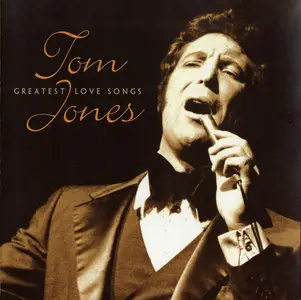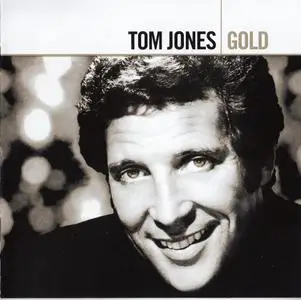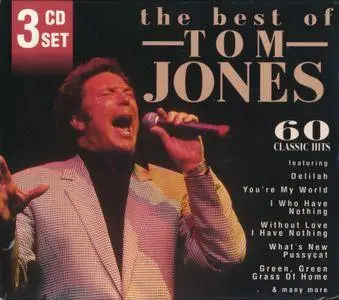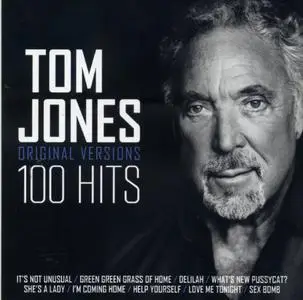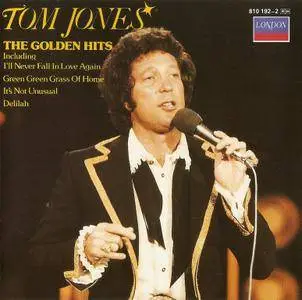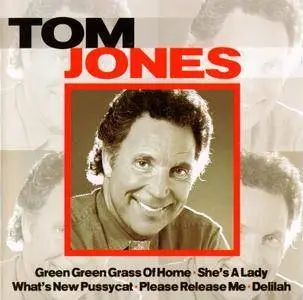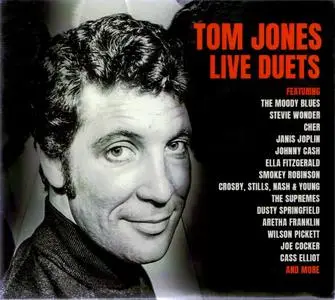Tom Jones
Tom Jones - Greatest Love Songs (2003) Music
Posted by Designol at Nov. 4, 2024
Tom Jones - Greatest Love Songs (2003)
EAC | FLAC | Image (Cue&Log) ~ 339 Mb | Mp3 (CBR320) ~ 143 Mb | Scans included
Label: Hip-O/Universal | # 440 069 586-2 | Time: 00:52:04
AM Pop, Vocal Pop, Pop/Rock, Blue-Eyed Soul
EAC | FLAC | Image (Cue&Log) ~ 339 Mb | Mp3 (CBR320) ~ 143 Mb | Scans included
Label: Hip-O/Universal | # 440 069 586-2 | Time: 00:52:04
AM Pop, Vocal Pop, Pop/Rock, Blue-Eyed Soul
GREATEST LOVE SONGS (Hip-O Records), released January 28, 2003, collects 17 of the hit songs and fan favorites from the swingin' '60s and early '70s – eight of them U.S. Top 40s – that set the emotion in motion.
Tom Jones - Gold (1965-1975) (2005) Music
Posted by JET 1 at Feb. 11, 2021
Tom Jones - Gold (1965-1975) (2005)
EAC Rip | FLAC (Tracks) +CUE, LOG | 991 MB | Scans
Genre: Rock, Pop, Vocal | Label: Hip-O Records / Deram Records | Catalog Number: 0602498209714
EAC Rip | FLAC (Tracks) +CUE, LOG | 991 MB | Scans
Genre: Rock, Pop, Vocal | Label: Hip-O Records / Deram Records | Catalog Number: 0602498209714
Tom Jones Gold is a two-disc, 42-track set that does an admirable job of mixing all his major hits recorded between 1965 and 1975 for the American Parrot label with well-chosen album tracks and B-sides. Interestingly, the U.K. Deram versions of Jones' singles and albums would occasionally differ slightly from the U.S. releases. All eight of those tracks are wisely included on Gold along with remastered favorites like "Delilah," "She's a Lady," "What's New Pussycat?" "Green, Green Grass of Home," "I (Who Have Nothing)" and "Help Yourself." Recommended for those who want to go a step beyond the average greatest-hits package.
Tom Jones - The Best Of Tom Jones: 60 Classic Hits (1999) {3CD Box Set} Music
Posted by popsakov at Sept. 30, 2020
Tom Jones - The Best Of Tom Jones: 60 Classic Hits (1999) {3CD Box Set}
EAC Rip | FLAC (Img) + Cue + Log ~ 648 Mb | MP3 CBR320 ~ 381 Mb
Full Scans ~ 234 Mb | 02:37:47 | RAR 5% Recovery
Pop, Rock, Vocal | MasterSound #590322
EAC Rip | FLAC (Img) + Cue + Log ~ 648 Mb | MP3 CBR320 ~ 381 Mb
Full Scans ~ 234 Mb | 02:37:47 | RAR 5% Recovery
Pop, Rock, Vocal | MasterSound #590322
Tom Jones became one of the most popular vocalists to emerge from the British Invasion. Since the mid-'60s, Jones has sung nearly every form of popular music – pop, rock, show tunes, country, dance, and techno, he's sung it all. His actual style – a full-throated, robust baritone that had little regard for nuance and subtlety – never changed, he just sang over different backing tracks. On-stage, Jones played up his sexual appeal; it didn't matter whether he was in an unbuttoned shirt or a tuxedo, he always radiated a raw sexuality that earned him a large following of devoted female fans who frequently threw underwear on-stage. Jones' following never diminished over the decades; he was able to exploit trends, earning new fans while retaining his core following.
Tom Jones - A-Tom-ic Jones (1966) {1989, Reissue} Music
Posted by popsakov at Sept. 28, 2020
Tom Jones - A-Tom-ic Jones (1966) {1989, Reissue}
EAC Rip | FLAC (Img) + Cue + Log ~ 348 Mb | MP3 CBR320 ~ 123 Mb
Full Scans ~ 89 Mb | 00:50:50 | RAR 5% Recovery
Pop, Blue-Eyed Soul | Deram #820 556-2
EAC Rip | FLAC (Img) + Cue + Log ~ 348 Mb | MP3 CBR320 ~ 123 Mb
Full Scans ~ 89 Mb | 00:50:50 | RAR 5% Recovery
Pop, Blue-Eyed Soul | Deram #820 556-2
A-Tom-Ic Jones, Jones' cleverly titled third album, featured no major hit singles and failed to chart in the U.S. Jones sings well, but he doesn't have the material to match his performance, making the album noticeably weaker than his first two collections.
Tom Jones - Spirit In The Room (2013) Music
Posted by popsakov at Oct. 22, 2022
Tom Jones - Spirit In The Room (2013)
EAC Rip | FLAC (Img) + Cue + Log ~ 288 Mb | MP3 CBR320 ~ 122 Mb
Full Scans ~ 111 Mb | 00:50:40 | RAR 5% Recovery
Pop Rock, Blues, Country, Blue-Eyed Soul | Rounder Records #11661-9163-2 | US
EAC Rip | FLAC (Img) + Cue + Log ~ 288 Mb | MP3 CBR320 ~ 122 Mb
Full Scans ~ 111 Mb | 00:50:40 | RAR 5% Recovery
Pop Rock, Blues, Country, Blue-Eyed Soul | Rounder Records #11661-9163-2 | US
Although it isn't the revelation or surprising, extraordinary achievement that his 2010 record Praise & Blame was, Spirit in the Room is another solid, very welcome set of stripped-back interpretations from Tom Jones, produced once again by Ethan Johns, making those comparisons to Johnny Cash's late-period recordings with Rick Rubin all the more fitting. Know that the songbook has changed from classic (spirituals, blues, and traditional numbers) to more contemporary (Paul Simon, Leonard Cohen, Paul McCartney, the Low Anthem, and others) and that Jones and Johns are both in top form and you've got the picture, along with that same frustration that no matter how fun "What's New Pussycat?" and "Sex Bomb" were, a couple more albums like this along the way would have been rich and rewarding.
Tom Jones - 100 Hits (2012) Music
Posted by El Misha at Aug. 24, 2020
Tom Jones - 100 Hits (2012)
EAC Rip | FLAC (image & cue & log) -> 2.05 GB | Covers | 5:22:30
Genre: Pop, Rock | Label: Universal Music, TVCD | #533937
EAC Rip | FLAC (image & cue & log) -> 2.05 GB | Covers | 5:22:30
Genre: Pop, Rock | Label: Universal Music, TVCD | #533937
Tom Jones became one of the most popular vocalists to emerge from the British Invasion. Since the mid-'60s, Jones has sung nearly every form of popular music – pop, rock, show tunes, country, dance, and techno, he's sung it all. His actual style – a full-throated, robust baritone that had little regard for nuance and subtlety – never changed, he just sang over different backing tracks. On-stage, Jones played up his sexual appeal; it didn't matter whether he was in an unbuttoned shirt or a tuxedo, he always radiated a raw sexuality that earned him a large following of devoted female fans who frequently threw underwear on-stage. Jones' following never diminished over the decades; he was able to exploit trends, earning new fans while retaining his core following.
Tom Jones - The Golden Hits (1986) Music
Posted by popsakov at Aug. 28, 2020
Tom Jones - The Golden Hits (1986)
EAC Rip | FLAC (Img) + Cue + Log ~ 258 Mb | MP3 CBR320 ~ 104 Mb
Full Scans ~ 82 Mb | 00:43:05 | RAR 5% Recovery
Pop | London #810 192-2
EAC Rip | FLAC (Img) + Cue + Log ~ 258 Mb | MP3 CBR320 ~ 104 Mb
Full Scans ~ 82 Mb | 00:43:05 | RAR 5% Recovery
Pop | London #810 192-2
Tom Jones became one of the most popular vocalists to emerge from the British Invasion. Since the mid-'60s, Jones has sung nearly every form of popular music – pop, rock, show tunes, country, dance, and techno, he's sung it all. His actual style – a full-throated, robust baritone that had little regard for nuance and subtlety – never changed, he just sang over different backing tracks. On-stage, Jones played up his sexual appeal; it didn't matter whether he was in an unbuttoned shirt or a tuxedo, he always radiated a raw sexuality that earned him a large following of devoted female fans who frequently threw underwear on-stage. Jones' following never diminished over the decades; he was able to exploit trends, earning new fans while retaining his core following.
Tom Jones - Tom Jones (2006) Music
Posted by popsakov at Nov. 17, 2020
Tom Jones - Tom Jones (2006)
EAC Rip | FLAC (Img) + Cue + Log ~ 277 Mb | MP3 CBR320 ~ 132 Mb
Full Scans | 00:40:20 | RAR 5% Recovery
Pop | Compilation | Universe / Falcon Neue Medien #3767
EAC Rip | FLAC (Img) + Cue + Log ~ 277 Mb | MP3 CBR320 ~ 132 Mb
Full Scans | 00:40:20 | RAR 5% Recovery
Pop | Compilation | Universe / Falcon Neue Medien #3767
Tom Jones became one of the most popular vocalists to emerge from the British Invasion. Since the mid-'60s, Jones has sung nearly every form of popular music – pop, rock, show tunes, country, dance, and techno, he's sung it all. His actual style – a full-throated, robust baritone that had little regard for nuance and subtlety – never changed, he just sang over different backing tracks. On-stage, Jones played up his sexual appeal; it didn't matter whether he was in an unbuttoned shirt or a tuxedo, he always radiated a raw sexuality that earned him a large following of devoted female fans who frequently threw underwear on-stage. Jones' following never diminished over the decades; he was able to exploit trends, earning new fans while retaining his core following.
Tom Jones - Live at Caesars Palace (1971) Remastered 1998 Music
Posted by Designol at Feb. 6, 2023
Tom Jones - Live at Caesars Palace (1971) Remastered 1998
EAC | FLAC | Image (Cue&Log) ~ 357 Mb | Mp3 (CBR320) ~ 138 Mb | Scans included | 00:58:48
AM Pop, Vocal Pop, Contemporary Pop/Rock | Label: Varèse Vintage | # VSD-5898
EAC | FLAC | Image (Cue&Log) ~ 357 Mb | Mp3 (CBR320) ~ 138 Mb | Scans included | 00:58:48
AM Pop, Vocal Pop, Contemporary Pop/Rock | Label: Varèse Vintage | # VSD-5898
For many acts, the casino circuit is the kiss of death creatively, but in the case of Tom Jones the exact opposite is true – amidst the neon lights, craps tables, and slot machines, he's at the top of his game, feeding on the energy and excitement to command the stage with a power and eroticism that are virtually unmatched. Recorded in Las Vegas in the spring of 1971, Live at Caesar's Palace – his tenth and final gold record – captures Jones at his bawdy best, offering a compelling mix of hits and covers while still managing to make time with the ladies between songs; riding high on the recent success of "She's a Lady," he also samples smashes like "It's Not Unusual" and "Delilah" in addition to a vast range of material spanning from "Soul Man" to "Bridge Over Troubled Water" to "My Way." The between-song stage patter is priceless as well – for fans, this is an essential set.
Tom Jones - Live Duets (2023) Music
Posted by popsakov at Jan. 20, 2024
Tom Jones - Live Duets (2023)
2CD | EAC Rip | FLAC (Img) + Cue + Log ~ 428 Mb | MP3 CBR320 ~ 252 Mb
Scans Included | 00:55:43 + 00:46:59 | RAR 5% Recovery
Pop, Rhythm & Blues, Soul, Rock, Ballad | London Calling #LC2C05138
2CD | EAC Rip | FLAC (Img) + Cue + Log ~ 428 Mb | MP3 CBR320 ~ 252 Mb
Scans Included | 00:55:43 + 00:46:59 | RAR 5% Recovery
Pop, Rhythm & Blues, Soul, Rock, Ballad | London Calling #LC2C05138
"I was trying to find the thread that connects one type of music - one type of musician - toanother, and to follow that thread in some kind of natural, evolutionary way." - (Tom Jones on the "This Is Tom Jones' TV show)
In the handful of years that the show aired on television, a host of famous actors, comedians and singers graced the stage. After it made its debut appearance, the programme went on to have two more series with a total of 65 episodes by the time it came to an end in 1971. Perhaps most impressive was the calibre of musical talent that Jones managed to book for the show. The series’ ran from 1969 to 1971 and saw him singing with everyone from Jerry Lee Lewis to Crosby, Stills, Nash & Young. Jones’ authenticity as a singer and performer shine through on these prized duets that often highlighted his own musical tastes which were varied and eclectic. London Calling revisits these incredible performances, made for prime time television audiences in the UK and USA over 50 years ago. Featuring an array of exclusive performances from iconic artists in the captivating company of the one and only Tom Jones! Fully restored and professionally remastered original TV broadcasts, presented with background notes and timeline photos.
